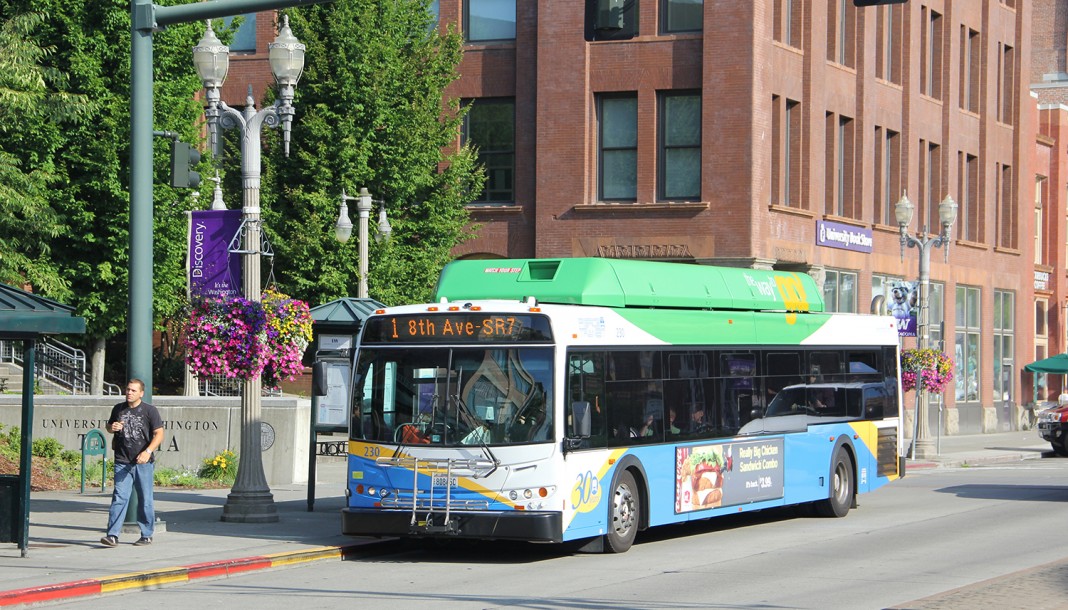Submitted by Pierce Transit
Pierce Transit is partnering with Lyft, the fastest growing rideshare company in the U.S., to provide free first-last mile rides to select Pierce Transit bus routes, as well as the Puyallup Sounder Station.
Many people across the United States have a hard time using public transportation. There may be limited service near them, or they are too far from a bus or train. In late 2016, Pierce Transit became one of 11 public transportation providers across the United States selected to take part in the Federal Transit Administration’s Mobility on Demand (MOD) Sandbox grant program, an opportunity for agencies to experiment with new, integrated, multimodal transportation options for the public. Pierce Transit is also collaborating with local partners Sound Transit and Pierce College Puyallup to deliver an innovative, community mobility pilot program it is calling “Limited Access Connections.”
In addition to providing first-last mile access to transit, the project will also provide students at Pierce College Puyallup a grant-funded ride home in the evening after transit services have ended to select locations near campus. In most zones, riders can also take a Lyft ride from their transit drop-off point back to their destination within a designated area. The Limited Access Connection project’s goals include addressing mobility challenges for those with limited or no access to transit; finding solutions for the growing problem of at-capacity Park & Rides; reducing road congestion by getting more people on transit; guaranteeing a ride home for those traveling outside regular bus service hours; and meeting the transportation needs of more remote riders. These objectives are unique in that they are focused on helping connect people to/from transit. Every trip will be multimodal in nature, using ridesharing as a first-last mile bridge to the region’s core transit network.
The new project will kick off with outreach at Pierce College Puyallup Monday, May 21, from 11:00 a.m. to 1:00 p.m. in the college’s center courtyard area located between the College Center, Library/Science and Administration buildings (college map here). The outreach will inform students, staff and faculty about how to use the program, and Lyft and Pierce Transit representatives will be on hand to answer questions.
Customers will find more information about the Limited Access Connections program, including an interactive map showing zone boundaries and transit drop-off locations, at piercetransit.org/limited-access-connections.
“We are very pleased to partner with Lyft on this new mobility option that will provide many people in Pierce County a much-needed solution for getting to school, jobs, medical appointments and other important destinations,” said Pierce Transit CEO Sue Dreier. “We are also grateful to our congressional delegation for their support in obtaining this grant funding, and are looking forward to seeing the results.”
“We are excited to be working with Pierce Transit and the FTA Sandbox program on this unique partnership aimed at improving access and increasing utilization of public transit,” said Todd Kelsay, Lyft’s Pacific Northwest general manager. “These new community mobility programs will help bridge gaps in local transit coverage and provide better access to the region’s core commuter bus and rail network.”
How the Limited Access Connections program works
- For those that haven’t used Lyft yet, they will need to download the Lyft app on their smartphone and set up an account.
- Riders will request a ride from within a designated zone using the Lyft app and a promotional code associated with that zone. If that zone is active when a rider makes the request, the requester will see a zero cost ride when they confirm their ride. (See the Limited Access Connections brochure/webpage for zone maps, hours of eligibility within each zone, and zone codes.)
- Riders without a smartphone, or those who need a wheelchair accessible vehicle, may call 253-581-8032 between 6:00 a.m. and 10:30 p.m. and a customer service representative will assist them in arranging their trip. Accessible vehicles will not be requested through the Lyft app at the outset of the program.
- This is a pilot project with limited funding; in order to allow as many people as possible to try it, riders are limited to a maximum of 48 free eligible Lyft rides per month.
Zones, times and codes (See brochure/webpage for map and additional details.):
- Zone A: East Puyallup Commuter and Fife Commuter. From East Puyallup, rides are provided to/from the Puyallup Sounder Station. From Fife, rides are provided to select bus stops and the Sounder Station. Monday through Friday, 5:00 a.m. to 7:00 p.m. Promo code: 18FIFEPUY
- Zone B: Pierce College Puyallup Guaranteed Ride Home. A guaranteed ride home after transit ends for the evening; from Pierce College Puyallup to destinations within the East Puyallup zone and South Hill Mall Transit Center. Monday through Friday, 8:30 p.m. to 10:30 p.m. Promo code: 18RAIDERS
- Zone C: Browns Point/NE Tacoma Connection with Tacoma Dome Station. When Route 63 between NE Tacoma and downtown Tacoma is not operating, this program will provide a ride between NE Tacoma and the Tacoma Dome Station multimodal facility. Seven days a week, 9:00 a.m. to 4:00 p.m. Promo code: 18TDS
- Zone D: Spanaway/Parkland, Midland and University Place Connections. Provides riders in Spanaway/Parkland, Midland and University Place who cannot otherwise reach transit with a connection to select bus stops. Promo codes (use code specific to your location): 18SPANPARK; 18MIDLAND; 18UPLACE
These zones are generally lower-density areas that are not as well-served with fixed route bus services.
Pierce Transit’s congressional delegation supported the agency’s grant application for this project, including U.S. Senators Patty Murray and Maria Cantwell, and U.S. Representatives Heck, Kilmer, Smith and Reichert. The agency was awarded $205,000 to conduct the pilot project. Following the pilot the Federal Transit Administration will evaluate the program’s impacts, including whether it helped increased mobility. Pierce Transit will also analyze the results for possible future innovative programs aimed at reaching riders who may not currently have access to transit.














































